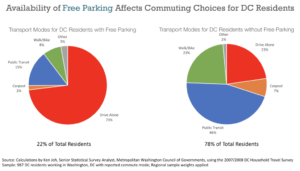Making Workforce Housing Work: Understanding Housing Needs for D.C.’s Changing Workforce
D.C.’s workforce is growing and changing. After years of decline, the city is now a leading jurisdiction in population and job growth. Increasingly, more people working in D.C. want to live in D.C., though the city still has a net influx of commuters to fill jobs each workday. This growth dynamic offers the District new opportunities, but also continued housing affordability challenges that must be addressed strategically to make the lives of working households better, and foster a healthy economy. D.C. can and should affordably house more of its workforce. To accomplish this, the District must deploy two broad strategies:
- Make the housing market work better by changing land use policies to provide the housing supply necessary to keep pace with demand from working households who could pay for housing if it were more available and less costly.
- Use subsidies and a full set of public policy tools to bridge the remaining gap where housing costs are too high and wages too low. The District should dramatically increase funding for the Local Rent Supplement Program and Housing Production Trust Fund. It should also leverage Inclusionary Zoning, Planned Unit Developments and other zoning tools to produce more housing that is affordable. These investments and policy tools must make homes affordable for workers who are filling common occupations but face severe housing cost burdens. This essential part of the workforce earns half or less of the region’s median household income.
This paper focuses on the latter issue: specifically, the need to target public resources and policies to addressing the needs of the large share of the workforce that earns 50 percent or less of area median income. These workers represent 8 of the 20 most common occupations in the District of Columbia, and 5 of those 8 occupations pay wages that amount to 30 percent or less of area median income.
View full report at: Making Workforce Housing Work


